3 types of macromolecules - Study guides, Class notes & Summaries
Looking for the best study guides, study notes and summaries about 3 types of macromolecules? On this page you'll find 1458 study documents about 3 types of macromolecules.
Page 3 out of 1.458 results
Sort by

-
Honors Biology Chapter 2 Questions with Complete Solutions
- Exam (elaborations) • 20 pages • 2024
- Available in package deal
-
- $9.99
- + learn more
Honors Biology Chapter 2 Questions with Complete Solutions What is the function of nucleic acids in cells? Nucleic acids store and transmit genetic information, with DNA carrying the genetic blueprint and RNA playing a role in protein synthesis. What is a peptide bond? A peptide bond is a covalent bond formed between the amino group of one amino acid and the carboxyl group of another, linking amino acids in proteins. How do carbohydrates contribute to cellular energy? Carbo...

-
ASU BIO 201: FINAL EXAM QUESTIONS AND ANSWERS GRADED A+
- Exam (elaborations) • 33 pages • 2024
- Available in package deal
-
- $10.49
- + learn more
ASU BIO 201: FINAL EXAM QUESTIONS AND ANSWERS GRADED A+ 12 how many cranial nerves? 2 effects of dual innervation Antagonistic effects oppose each other: pupillary dilator and constrictor muscle, heart slowed down or speeded up Cooperative effects seen when 2 division act on different effectors to produce a unified effect 3 routes of sympathetic innervation Spinal nerve route: effectors in body wall are innervated by sympathetic fibers that exit a ganglion by the gray ramus and tr...
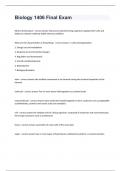
-
biol 1406 Collin College -Biology 1406 Final Exam
- Exam (elaborations) • 69 pages • 2024
- Available in package deal
-
- $19.99
- + learn more
biol 1406 Collin College -Biology 1406 Final Exam What is homeostasis - correct answer the process whereby living organisms regulate their cells and bodies to maintain relatively stable internal conditions What are the characteristics of living things - correct answer 1. Cells and Organization 2. Energy use and metabolism 3. Response to environmental changes 4. Regulation and homeostasis 5. Growth and Development 6. Reproduction 7. Biological Evolution atom - correct answer the smal...

-
IB Biology Chapter 2 Latest 2024 Graded A+
- Exam (elaborations) • 11 pages • 2024
- Available in package deal
-
- $8.99
- + learn more
IB Biology Chapter 2 Latest 2024 Graded A+ Vitalism Idea that living organisms are fundamentally different from non living things Most frequently occurring elements Oxygen 65% Carbon 19% Hydrogen 10% Nitrogen 3% Other elements Calcium 1.5% Phosphorus 1% Iron 0.7% Sulfur 0.25% Sodium 0.15% Molecular biology Science that aims to explain living processes in terms of chemical substances Synthesis of urea Discovered in human urine in the 18th century Organic compound synt...
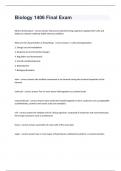
-
Biology 1406 Final Exam fully solved
- Exam (elaborations) • 69 pages • 2024
-
Available in package deal
-
- $22.99
- + learn more
Biology 1406 Final ExamWhat is homeostasis - correct answer the process whereby living organisms regulate their cells and bodies to maintain relatively stable internal conditions What are the characteristics of living things - correct answer 1. Cells and Organization 2. Energy use and metabolism 3. Response to environmental changes 4. Regulation and homeostasis 5. Growth and Development 6. Reproduction 7. Biological Evolution atom - correct answer the smallest component of an element...

-
BIOD 171 Portage Learning Final Exam Review questions with Complete Solutions rated A+
- Exam (elaborations) • 25 pages • 2024
-
Available in package deal
-
- $9.99
- + learn more
BIOD 171 Portage Learning Final Exam Review questions with Complete Solutions rated A+ True/False. A virus is considered a microorganism. - False, Viruses are not living and as such are not considered microorganisms. Viruses can, however, be classified as microbes, a more general term that includes microorganisms and viruses. What is the smallest biological unit of life? - A cell What are the four main types of macromolecules found in cells? - Proteins, Lipids, Nucleic Acids, Carbohydrates P...

-
Biology 1406 Final Exam Questions And 100% Correct Answers 2024.
- Exam (elaborations) • 68 pages • 2024
-
Available in package deal
-
- $9.99
- + learn more
What is homeostasis - Answer the process whereby living organisms regulate their cells and bodies to maintain relatively stable internal conditions What are the characteristics of living things - Answer 1. Cells and Organization 2. Energy use and metabolism 3. Response to environmental changes 4. Regulation and homeostasis 5. Growth and Development 6. Reproduction 7. Biological Evolution atom - Answer the smallest component of an element having the chemical properties of the el...
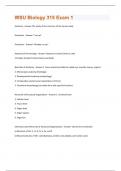
-
WSU Biology 315 Exam 1 Questions and Answers with complete solution
- Exam (elaborations) • 34 pages • 2024
- Available in package deal
-
- $7.99
- + learn more
Anatomy - Answer-The study of the structure of the human body Dissection - Answer-"I cut up" Prosection - Answer-"Already cut up" Anatomical Terminology - Answer--Based on ancient Greek or Latin -Provides standard nomenclature worlwide Branches of Anatomy - Answer-1. Gross anatomy (visible to naked eye; muscles, bones, organs) 2. Microscopic anatomy (histology) 3. Developmental anatomy (embryology) 4. Comparative anatomy (correspondence of form) 5. Functional morphology (correlate f...
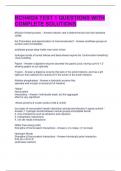
-
BCH4024 TEST 1 QUESTIONS WITH COMPLETE SOLUTIONS
- Exam (elaborations) • 16 pages • 2024
-
- $13.19
- + learn more
BCH4024 TEST 1 QUESTIONS WITH COMPLETE SOLUTIONS diffusion-limited process: - Answer-reaction rate is determined by how fast reactants collide the Protonation and deprotonation of macromolecules? - Answer-acid/base groups on surface react immediately acid/base groups deep inside may never ionize hydrogen bonds of buried helices and beta-sheets require the "conformation breathing" -local unfolding Pepsin - Answer-a digestive enzyme secreted into gastric juice, having a pH of 1.5 a...
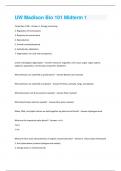
-
UW Madison Bio 101 Midterm 1 Questions and Answers(A+ Solution guide)
- Exam (elaborations) • 9 pages • 2024
-
- $7.99
- + learn more
Properties of life - Answer-1. Energy processing 2. Regulation of homeostasis 3. Response to environment 4. Reproduction 5. Growth and development 6. Evolutionary adaptation 7. Organization ( in cells and ecosystems) Levels of biological organization - Answer-molecule, organelle, cell, tissue, organ, organ system, organism, population, community, ecosystem, biosphere What domains are classified as prokaryotes? - Answer-Bacteria and archaea What domains are classified as eukarya? - Answ...

Study stress? For sellers on Stuvia, these are actually golden times. KA-CHING! Earn from your study resources too and start uploading now. Discover all about earning on Stuvia


